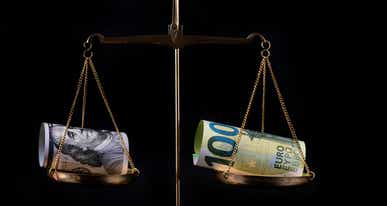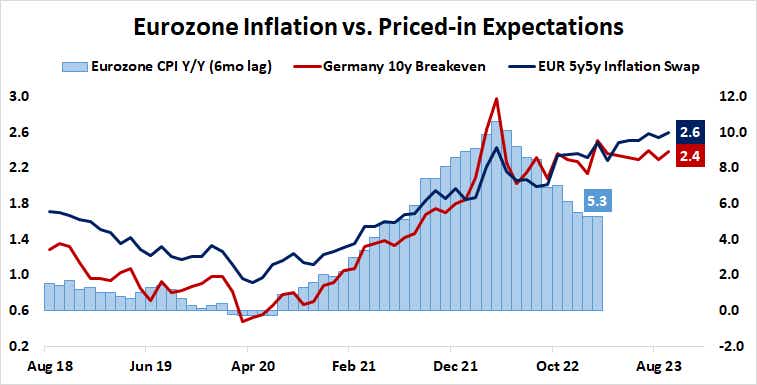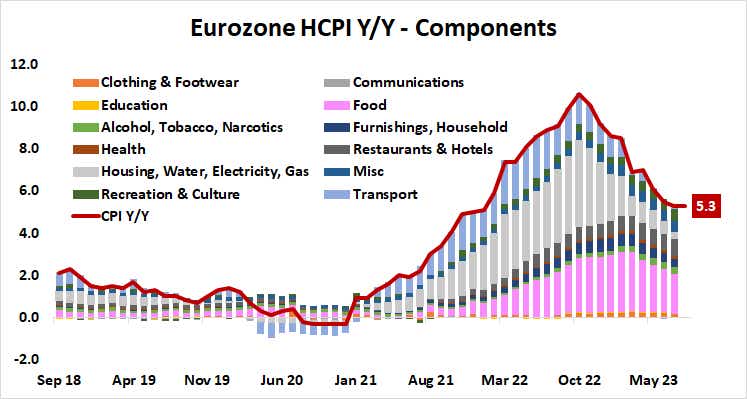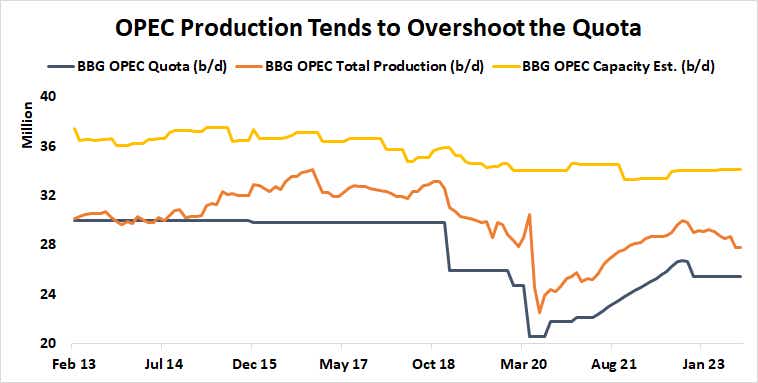EUR/USD: Euro Will Fall if ECB Rate Hikes Pause Despite Oil Output Cuts

EUR/USD: Euro Will Fall if ECB Rate Hikes Pause Despite Oil Output Cuts
By:Ilya Spivak
The euro may fall if Saudi cuts in crude oil output fail to subvert disinflation, allowing the ECB to end rate hikes
- The goods sector is driving Eurozone inflation, with food prices now in the spotlight.
- Saudi Arabia may struggle to cut output and thus bring lasting gains to crude oil prices.
- The euro will fall if easing inflation brings down the odds of another ECB rate hike.
The euro has dropped to the lowest level in three months against the U.S. dollar. The decline may continue as a deepening economic downturn and shifting inflation dynamics drive markets to rethink the likelihood of another interest rate hike from the European Central Bank (ECB).
August’s purchasing manager index (PMI) data offered a sobering view of the Eurozone economy, suggesting a recession is all but certainly in view. The numbers showed that region-wide activity contracted for a second consecutive month as the service sector crumbled, catching up to weakness seen on the manufacturing side since mid-2022.
Stubbornly high inflation complicates matters. At 5.3%, the headline consumer price index (CPI) is a long way from the ECB’s 2% objective. Worse still, the markets don’t seem to think the central bank has what it takes to deliver on its mandate. Leading measures of inflation expectations priced into the bond and swaps markets are pointedly trending in the wrong direction.

This has investors positing that another 25-basis-point (bps) interest rate hike is likelier than not before year-end. Overnight index swap (OIS) market pricing puts the probability of such a rise at just over 63%. The euro would probably fall if those odds became longer.
Food prices in the Eurozone
As with Germany—the euro area’s largest economy—most of the region-wide inflation problem is still on the “goods” side of the ledger. That contrasts with services-driven inflation in the U.S. Falling gas prices have been the main driver of disinflation from last year’s highs. Food prices have taken over as the largest contributing factor.

Trying to bring down food inflation with interest rate hikes is a suspect endeavor. There’s not much that the central bank can do with borrowing costs to turn off hunger. However, price action in the commodity markets suggests disinflation may be starting to take shape on its own.
Grain prices peaked in early 2022 when Russia invaded Ukraine and began to trend lower in a move that preceded even the subsequent peak in energy prices. Rising soft commodities costs are a likelier culprit, with a blistering surge in the price of sugar probably most at fault.

Pressure in softs seems to have started easing in the past two months, but a pickup on the energy side now threatens to complicate matters. That comes as crude oil prices rebound thanks to a Saudi Arabia pledge to extend through December the production cutback program of 1 million barrels per day (bpd) unveiled in July.
Will crude oil output cuts keep the ECB in hawkish mode? Not so fast
The markets took the move to mean higher energy costs will filter into inflation and delay global central banks’ exit from the rate hike cycle. This reading assumes the output cut can truly make a dent in global supply vs. demand dynamics. History argues otherwise.
The Organization for Petroleum Exporting Countries (OPEC)—the oil cartel with Saudi Arabia in pole position—has been unable to bring production down to its stated target since 2014. So far this year, producers have exceeded their objective by an average of 3.2 million bpd.

The Kingdom must hope its 1 million bpd output cut can still make a dent against this backdrop, even as slowing global growth undercuts demand and pressures prices lower. If the effort fizzles, the ECB may be spared an inflationary handoff from soft to energy commodities.
Traders will surely notice if the cool-off in consumer prices gains momentum in such a scenario and readjust their monetary policy expectations accordingly. That carries bearish implications for the euro as yield differentials widen against currencies where stickier prices underpin greater appetite for tightening (like the U.S. dollar).
Ilya Spivak, tastylive head of global macro, has 15 years of experience in trading strategy, and he specializes in identifying thematic moves in currencies, commodities, interest rates and equities. He hosts Macro Money and co-hosts Overtime, Monday-Thursday. @Ilyaspivak
For live daily programming, market news and commentary, visit tastylive or the YouTube channels tastylive (for options traders), and tastyliveTrending for stocks, futures, forex & macro.
Trade with a better broker, open a tastytrade account today. tastylive, Inc. and tastytrade, Inc. are separate but affiliated companies.
Options involve risk and are not suitable for all investors. Please read Characteristics and Risks of Standardized Options before deciding to invest in options.